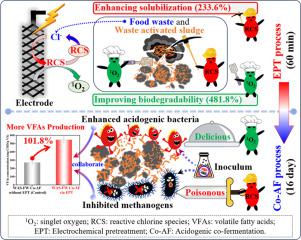当前位置:
X-MOL 学术
›
Water Res.
›
论文详情
Our official English website, www.x-mol.net, welcomes your feedback! (Note: you will need to create a separate account there.)
Electrogenerated singlet oxygen and reactive chlorine species enhancing volatile fatty acids production from co-fermentation of waste activated sludge and food waste: The key role of metal oxide coated electrodes
Water Research ( IF 11.4 ) Pub Date : 2024-06-17 , DOI: 10.1016/j.watres.2024.121953 Qingshan Lin 1 , Shihao Xi 2 , Boyi Cheng 2 , Jinqi Jiang 2 , Feixiang Zan 2 , Yuanzhe Tang 3 , Yeqing Li 4 , Samir Kumar Khanal 5 , Zongping Wang 2 , Guanghao Chen 6 , Gang Guo 2
Water Research ( IF 11.4 ) Pub Date : 2024-06-17 , DOI: 10.1016/j.watres.2024.121953 Qingshan Lin 1 , Shihao Xi 2 , Boyi Cheng 2 , Jinqi Jiang 2 , Feixiang Zan 2 , Yuanzhe Tang 3 , Yeqing Li 4 , Samir Kumar Khanal 5 , Zongping Wang 2 , Guanghao Chen 6 , Gang Guo 2
Affiliation

|
Electrochemical pretreatment (EPT) has shown to be superior in improving acidogenic co-fermentation (Co-AF) of waste activated sludge (WAS) and food waste (FW) for volatile fatty acids (VFAs). However, the influence of EPT electrode materials on the production of electrogenerated oxidants (such as singlet oxygen (O) and reactive chlorine species (RCS)), as well as their effects on properties of electrodes, the microbial community structure and functional enzymes remain unclear. Therefore, this study investigated the effects of various metal oxide coated electrodes (i.e., Ti/PbO, Ti/TaO-IrO, Ti/SnO-RuO, and Ti/IrO-RuO) on EPT and subsequent Co-AF of WAS-FW. The results showed that EPT with Ti/PbO, Ti/TaO-IrO, Ti/SnO-RuO and Ti/IrO-RuO electrodes generated 165.3–848.2 mg Cl/L of RCS and 5.643 × 10–3.311 × 10 spins/mm of O, which significantly enhanced the solubilization and biodegradability of WAS-FW by 106.4 %–233.6 % and 177.3 %–481.8 %, respectively. Especially with Ti/TaO-IrO as the electrode material, an appropriate residual RCS (2.0–10.4 mg Cl/L) remained in Co-AF step, resulted in hydrolytic and acidogenic bacteria (e.g., accounting for 78.9 %) gradually become dominant rather than methanogens (e.g., and ) due to their different tolerance to residual RCS. Meanwhile, the functional gene abundances of hydrolytic and acidogenic enzymes increased, while the methanogenic enzymes deceased. Consequently, this reactor produced the highest VFAs up to 545.5 ± 36.0 mg COD/g VS, which was 101.8 % higher than that of the Control (without EPT). Finally, the economic analysis and confirmatory experiments further proved the benefits of WAS-FW Co-AF with EPT.
中文翻译:

电产生的单线态氧和活性氯物质提高废活性污泥和食物垃圾共同发酵中挥发性脂肪酸的产量:金属氧化物涂层电极的关键作用
电化学预处理 (EPT) 已被证明在改善废弃活性污泥 (WAS) 和食物垃圾 (FW) 的挥发性脂肪酸 (VFA) 产酸共发酵 (Co-AF) 方面具有优越性。然而,EPT电极材料对电生氧化剂(如单线态氧(O)和活性氯物种(RCS))产生的影响,以及它们对电极性能、微生物群落结构和功能酶的影响仍不清楚。因此,本研究研究了各种金属氧化物涂层电极(即Ti/PbO、Ti/TaO-IrO、Ti/SnO-RuO和Ti/IrO-RuO)对WAS-FW的EPT和随后的Co-AF的影响。结果表明,使用 Ti/PbO、Ti/TaO-IrO、Ti/SnO-RuO 和 Ti/IrO-RuO 电极进行 EPT 产生 165.3–848.2 mg Cl/L 的 RCS 和 5.643 × 10–3.311 × 10 自旋/mm O,显着增强了 WAS-FW 的溶解度和生物降解性,分别提高了 106.4%–233.6% 和 177.3%–481.8%。特别是以Ti/TaO-IrO为电极材料时,Co-AF步骤中残留适当的RCS(2.0-10.4 mg Cl/L),导致水解和产酸细菌(例如占78.9%)逐渐占主导地位比产甲烷菌(例如,和),因为它们对残留 RCS 的耐受性不同。同时,水解酶和产酸酶的功能基因丰度增加,而产甲烷酶的功能基因丰度减少。因此,该反应器产生的 VFA 最高,高达 545.5 ± 36.0 mg COD/g VS,比对照(无 EPT)高 101.8%。最后,经济分析和验证实验进一步证明了WAS-FW Co-AF与EPT的优势。
更新日期:2024-06-17
中文翻译:

电产生的单线态氧和活性氯物质提高废活性污泥和食物垃圾共同发酵中挥发性脂肪酸的产量:金属氧化物涂层电极的关键作用
电化学预处理 (EPT) 已被证明在改善废弃活性污泥 (WAS) 和食物垃圾 (FW) 的挥发性脂肪酸 (VFA) 产酸共发酵 (Co-AF) 方面具有优越性。然而,EPT电极材料对电生氧化剂(如单线态氧(O)和活性氯物种(RCS))产生的影响,以及它们对电极性能、微生物群落结构和功能酶的影响仍不清楚。因此,本研究研究了各种金属氧化物涂层电极(即Ti/PbO、Ti/TaO-IrO、Ti/SnO-RuO和Ti/IrO-RuO)对WAS-FW的EPT和随后的Co-AF的影响。结果表明,使用 Ti/PbO、Ti/TaO-IrO、Ti/SnO-RuO 和 Ti/IrO-RuO 电极进行 EPT 产生 165.3–848.2 mg Cl/L 的 RCS 和 5.643 × 10–3.311 × 10 自旋/mm O,显着增强了 WAS-FW 的溶解度和生物降解性,分别提高了 106.4%–233.6% 和 177.3%–481.8%。特别是以Ti/TaO-IrO为电极材料时,Co-AF步骤中残留适当的RCS(2.0-10.4 mg Cl/L),导致水解和产酸细菌(例如占78.9%)逐渐占主导地位比产甲烷菌(例如,和),因为它们对残留 RCS 的耐受性不同。同时,水解酶和产酸酶的功能基因丰度增加,而产甲烷酶的功能基因丰度减少。因此,该反应器产生的 VFA 最高,高达 545.5 ± 36.0 mg COD/g VS,比对照(无 EPT)高 101.8%。最后,经济分析和验证实验进一步证明了WAS-FW Co-AF与EPT的优势。
















































 京公网安备 11010802027423号
京公网安备 11010802027423号